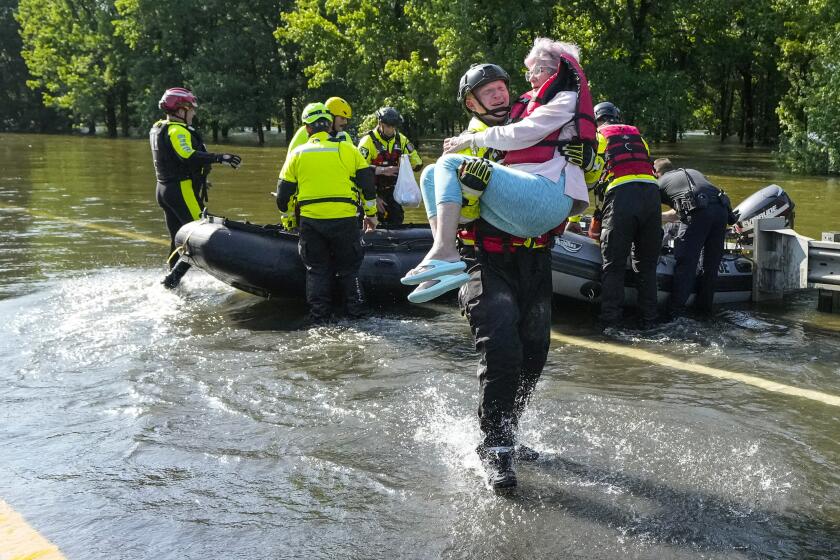Controversy Brews Over Monument Status for Shivwits Plateau
Sage, cedar and petroglyphs are plentiful on the Shivwits Plateau, a scenic strip of land between the Grand Canyon and the Utah line, and until now people have been scarce.
Interior Secretary Bruce Babbitt and others hope to keep it that way.
Babbitt, who hiked in the area as a youth, is proposing that a new 550,000-acre monument be formed over the plateau north of Grand Canyon National Park and the Lake Mead Recreation Area.
“There is a general consensus that the area is pristine and should be protected. The question is how?” said Interior Department spokesman John Wright. “The secretary makes no bones about it. He would like to see this thing done on his watch.”
The land, which is primarily controlled by federal and state governments, is home to a number of endangered and threatened species and features stunning views of side canyons to the Grand Canyon.
Local officials say they are receptive to the creation of a monument but remain wary of meddling by the federal government.
“We don’t want the government just going goofy and acquiring land,” said Kingman City Councilman Paul McCormick.
Brad Ack, spokesman for the Grand Canyon Trust, a conservation group, said those fears are unfounded since most of the Arizona Strip, the swath of land cut off from the rest of the state by the Colorado River, is already government-owned.
“For anyone to call it a land grab shows total ignorance of public lands. They are federal lands, our lands,” he said.
Much of the Shivwits Plateau, named for a band of Paiute Indians, was proposed in the 1970s as an addition to Grand Canyon National Park, but the Senate balked at the plan because cattle ranching and hunting are not allowed in national parks. Regulations for national monuments are more flexible.
Babbitt has said the grazing rights of area ranchers, many of whom come from generations-old Arizona Strip ranching families, should be protected in the proposed monument.
Wright said that under Babbitt’s proposal, new mining claims would be forbidden--a provision of which Sen. Jon Kyl (R-Ariz.) is leery.
“Before we lock up all the minerals, we better find out what’s there,” Kyl said. “I know that the secretary wants to move quickly. I think the members of Congress want to move more slowly.”
A national monument can be created by Congress or by presidential proclamation, as was done with the Grand Staircase-Escalante National Monument in southern Utah. That monument stirred controversy among local officials who saw President Clinton’s proclamation as heavy-handed.
Residents here say they are wary of the same thing occurring on the Shivwits Plateau.
Donald Van Brunt, executive director of the Mohave County Economic Development Authority, is adamant that the monument should be created by Congress so improvements the authority wants can be funded. The president cannot through a proclamation provide additional funding for the proposed monument.
The authority wants a paved road running to a scenic overlook, where visitors can look down a side canyon into the Grand Canyon, and an information center. Rough, winding dirt roads are all the area has now.
“It’s senseless to create the monument without the infrastructure,” Van Brunt said. “People of every walk of life should have the right to see it.”
By developing a destination point, Van Brunt said, people would be discouraged from wandering through the pristine wilderness.
“We’re getting many calls from people in the East wondering how to get to the monument,” he said. “We would rather [Babbitt] had never said anything, but now that he’s said something, they are going to come whether we want it or not.”
Environmental groups, however, oppose the idea of paved roads and a visitors’ center because they will attract more people.
Ack said the Grand Canyon Trust is hoping a monument designation will only increase the protection of the area.
The trust wants the national monument to include nearly twice as much land as Babbitt has proposed, which would extend it to the Utah line, to ensure wildlife corridors are protected and remain linked.
“We believe that that area is really important because of its remoteness and its wildness,” Ack said. “We want [Babbitt] to be more ambitious and to think much longer than the next 15 or 20 years.”
Because rapid development of the West has eaten up prime habitat for bighorn sheep, antelope, mule deer and desert tortoises, the Arizona Strip remains one of the last pristine places for the animals to live, Ack said.
“The reason they’re there is because we keep pushing animals into these areas,” he said.
More to Read
Start your day right
Sign up for Essential California for news, features and recommendations from the L.A. Times and beyond in your inbox six days a week.
You may occasionally receive promotional content from the Los Angeles Times.






